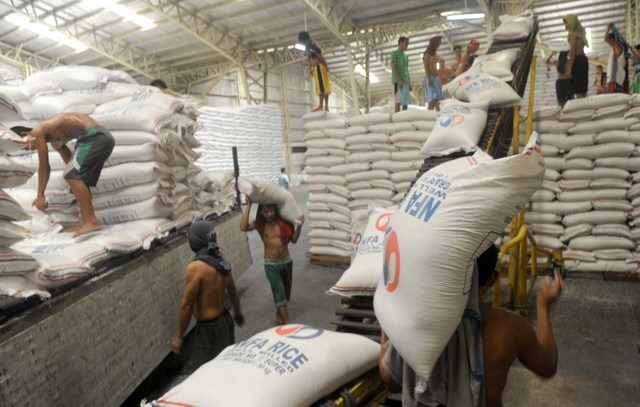SUMMARY
This is AI generated summarization, which may have errors. For context, always refer to the full article.

MANILA, Philippines – The National Food Authority (NFA) this week sounded the alarm over its depleted rice buffer stock.
Its spokesman has called on the NFA Council, chaired by Cabinet Secretary Leoncio Evasco Jr, to ensure rice imports arrive in April instead of May, as arranged.
For weeks now, the NFA’s rice stocks have been down to around two days’ worth of supply. The Inquirer reported on Tuesday, April 3, that the agency’s rice reserve has been “wiped out.”
But Malacañang and Evasco’s office say the current NFA rice shortage should not be cause for panic since NFA rice comprises only a small portion of the total rice supply of the country.
“NFA is only a small portion, 4 to 5% of the overall distribution of rice,” Evasco’s spokesman Assistant Secretary Jonas Soriano told reporters on Tuesday.
Yet Soriano also admitted that it is necessary to preserve NFA rice stocks since they are required to maintain a 15-day stock at any given time, and a 30-day stock at the onset of the lean months of July to September, to prepare for calamities.
“It really should not get depleted because if it does, what will we use for emergencies?” he said.
There are also concerns that depleted NFA rice reserves would lead to an increase in prices of rice, especially affecting low income households. But Malacañang says this could only happen if groups are taking advantage of the panic.
“An unusual rise in price despite more than adequate supplies could only be the result of manipulation,” Senior Deputy Executive Secretary Menardo Guevarra said on Tuesday.
NFA’s job
The NFA management, led by administrator Jason Aquino, is putting pressure on the NFA Council to speed up rice importation because of the dwindling NFA reserve. (READ: Tug-of-war between Evasco, NFA’s Aquino continues)
But Soriano’s remarks to media pose an interesting question: isn’t it NFA management’s job to ensure the reserve was not depleted?
The NFA Council, he said, wondered why the NFA distributed a lot of its rice stocks to retailers in October, November, and December – the harvest season.
“It was harvest season so why the need to sell so much rice? Yet during the lean season when there is not much rice, they did not sell so much, so where’s the logic?” Soriano said.
He stopped short of outrightly blaming NFA management. “We don’t want to make any judgement here,” said Soriano.
Senator Cynthia Villar, who chairs the chamber’s committee on agriculture, placed the blame squarely on Aquino’s shoulders, saying it was NFA’s job to maintain sufficient levels of its rice reserve.
“You should have buffer to make sure hindi ite-take advantage ng traders ang farmers. Sasabihin mo wala kang NFA rice, ‘eh trabaho mo ‘yan. Bakit mo ina-announce na hindi mo nagawa ang trabaho mo?” she said during a February 27 Senate hearing.
(You should have buffer to make sure traders would not take advantage of the farmers. You’ll say there’s no NFA rice but it’s your job. Why are you announcing that you could not do your job?)
Because of these concerns, the NFA Council wants an audit of NFA management’s operations, in particular how and when they distribute and sell NFA rice.
“That’s why one resolution is to already pursue the independent audit by COA to look at operations of management not only on October, November, December but henceforth, even ever since the start of the Duterte presidency,” said Soriano.
The NFA has two ways of replenishing its rice stocks. It can either buy from local farmers, something the Evasco-led NFA Council prefers, or it can import rice, which will also require the council’s approval.
NFA management says they can’t buy from local farmers because their buying price of P17 per kilogram is too low. Farmers would rather sell to others for a higher price.
The council, partly composed of economists, dispute this, saying farmers in some parts of the country had been willing to sell their rice for around that price back in October. So why did NFA management not take the opportunity then?
The need for importation
Because they can’t buy rice from Filipino farmers, NFA management insists the only recourse is rice importation.
President Rodrigo Duterte, seemingly convinced by Aquino, ordered the council to proceed with importing 250,000 metric tons of rice. Better too much rice than too little, the Chief Executive reasoned.
The rice, imported through private importers, is set to arrive in mid-May. NFA management, however, insists it must arrive earlier, in April, in order to replenish the “wiped out” NFA buffer stock.
Management, led by Aquino, thinks the importation should have been done through government-to-government importation, when the Philippines purchases rice from either Vietnam or Thailand, with which it has rice trade agreements.
Aquino says this method is faster and more transparent. The Evasco-led council, however, thinks otherwise. – Rappler.com
Add a comment
How does this make you feel?
There are no comments yet. Add your comment to start the conversation.